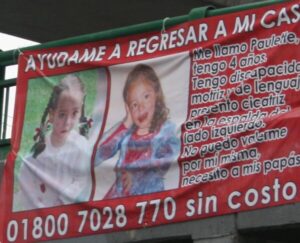The Haunting Mystery of Paulette Gebara Farah: The Girl Who Vanished—and Was Later Found in Her Own Bed

Some crimes haunt a nation forever—not just because of what happened, but because of how impossible they seem. The disappearance and death of four-year-old Paulette Gebara Farah remains one of the most perplexing and emotionally charged cases in modern Mexican history.
The story unfolded in March 2010 and began as every parent’s nightmare: a young child gone without a trace from her own bedroom. What followed—a massive search, televised appeals, official contradictions, and the shocking discovery that her body had been inside the apartment all along—left the entire country in disbelief. To this day, questions about what really happened have never been fully answered.
The Night Everything Changed
On March 21, 2010, little Paulette returned home with her father, Mauricio Gebara, and her sister after a weekend away. Their upscale apartment, located in Huixquilucan in the State of Mexico, was part of a gated residential complex equipped with private security and surveillance cameras.
That night, her mother, Lizette Farah, helped both girls prepare for bed. Paulette, born with developmental disabilities that affected her speech and coordination, needed gentle assistance and a consistent routine. Lizette tucked her in, surrounded by her favorite blankets and stuffed toys.
By dawn, everything had changed.
When one of the household nannies, Erika, entered the child’s room to wake her, Paulette’s bed was empty. The blankets were disheveled, her favorite stuffed animal was in its usual place—but the little girl was gone.
Panic erupted. The family, household staff, and building security began searching frantically. They checked closets, bathrooms, stairwells, the garden, and the garage. Doors were locked, windows closed, and security footage showed no intruders. There was no sign of forced entry, no broken glass, no clues.
Because Paulette’s mobility challenges made it nearly impossible for her to wander away on her own, the mystery deepened immediately.

A Massive Search and a Nation’s Attention
Within hours, the disappearance made headlines. Local police were joined by volunteers, K-9 units, and rescue teams. Flyers and billboards with Paulette’s picture appeared across Mexico. Television programs broadcast live updates, while hashtags and online campaigns urged the public to help find her.
Lizette Farah appeared on national television in emotional interviews, pleading for her daughter’s safe return. She described Paulette as a gentle, loving child with a bright smile and a trusting nature.
“Please,” she said tearfully, “if anyone has my daughter, return her. She is fragile, she needs care, she needs love.”
The case became a national obsession. But as days passed with no progress, the public’s empathy began turning into suspicion.
Turning Inward: The Investigation Takes a Dark Turn
By the seventh day of the search, investigators announced that inconsistencies had been found in the testimonies of the people closest to the child—her parents and the two nannies, Erika and Martha Casimiro. All four were placed under a legal restriction order (known as arraigo), preventing them from leaving the city while they were interrogated.
Attorney General Alberto Bazbaz told reporters that their statements contained contradictions about the night of the disappearance. Each person’s timeline differed slightly—when the girls were put to bed, when they were last seen, who entered the room first in the morning. The inconsistencies, coupled with the absence of physical evidence, fueled speculation that someone inside the apartment knew more than they were saying.
Forensic experts conducted a reconstruction of the night’s events inside the apartment, spreading blankets and re-creating the scene. Yet, even with these efforts, investigators found nothing to explain how a four-year-old could vanish in such a controlled environment.
The case dominated every news outlet. The public watched as the family’s private life was dissected on live television, and media crews broadcast from outside the apartment building 24 hours a day.

The Shocking Discovery
Then, on March 31, 2010, nine days after Paulette vanished, the unimaginable happened.
During yet another inspection of the family’s home—one that had already been scoured multiple times—investigators made a horrifying discovery. Paulette’s body was found inside her own bed, wedged tightly between the mattress and the footboard, wrapped in her own sheets and blankets.
The revelation stunned Mexico. How could a child have lain dead in the very room where her mother gave interviews, where forensic teams and police dogs had searched repeatedly, without anyone noticing?
Even more disturbingly, witnesses claimed that in the days following her disappearance, several people—including the mother—had slept in that very room. Search dogs had been inside. Television cameras had filmed there. And yet, for nine long days, no one found her.
When investigators finally uncovered the body, the smell of decomposition had become overwhelming. Leaked video from the discovery circulated online, with one officer allegedly remarking that the child appeared to have been “beaten.” Authorities quickly denied that statement.
The Autopsy: Official Findings Versus Public Doubt
According to the official autopsy, Paulette died of accidental mechanical asphyxia caused by obstruction of her airways and compression of her chest and abdomen.
Key findings included:
-
No signs of sexual assault or external trauma beyond minor bruises on the elbow and knee.
-
No evidence that the body had been moved post-mortem.
-
Toxicology tests negative for sedatives or drugs.
-
Estimated time of death: between five and nine days before discovery.
-
The report stated that Paulette likely slipped or rolled into the narrow gap at the foot of her bed, becoming trapped and unable to breathe.
Prosecutor Bazbaz asserted that it was a tragic accident, admitting that investigators had focused too heavily on external abduction theories and overlooked the possibility that the child remained inside the apartment.
However, few were convinced.
How could four adults, professional investigators, and K-9 units have missed the body? Why did the scent go undetected for so long? And why were the sheets wrapped around her in such an orderly manner if she had fallen by accident?
A Storm of Controversy
Public outrage exploded. The case that had united Mexico in grief now divided it in fury. Many believed the “accident” narrative was an attempt to shield someone powerful from blame.
The nannies, Erika and Martha, publicly insisted they had searched under and around the bed countless times. “There was no way she was there,” they said in interviews. “We looked everywhere.”
Politicians and journalists echoed the disbelief. Opposition leader Jesús Ortega famously asked, “How can more than a hundred police officers search a ten-square-meter room and not find a body?”
Under immense public pressure and mounting criticism, Attorney General Bazbaz resigned months later.
Aftermath and Lingering Shadows
Paulette was laid to rest in April 2010 at Panteón Francés de San Joaquín in Mexico City. Seven years later, in May 2017, her remains were exhumed and cremated after officials declared there were no further legal reasons to keep them preserved.
Yet the mystery has refused to fade. In 2020, the case regained international attention when Netflix released Crime Diaries: The Search (Historia de un crimen: La búsqueda), a dramatized series depicting the investigation. The show reignited debate over what really happened, with many viewers concluding that the official version left too many questions unanswered.
A Case That Still Defies Explanation
More than fifteen years later, the Paulette Gebara Farah case remains unresolved in the public mind. Officially, it is a tragic accident. Unofficially, it is one of the most confounding mysteries in Mexican legal history.
The contradictions still echo:
-
How could investigators, media crews, and family members occupy the same space for days without discovering her?
-
Why did search dogs fail to detect her scent?
-
And if it truly was an accident, why did the investigation involve so many inconsistencies, delays, and conflicting testimonies?
Every new retelling of the case brings a wave of speculation, theories, and sorrow. Some believe negligence and incompetence explain everything. Others are convinced a darker truth was buried alongside the child.
What remains undeniable is the heartbreak. A little girl lost her life under inexplicable circumstances, and a family—and a nation—was left with more questions than answers.
Even now, when people speak of Paulette, they do so with a mix of disbelief and sadness. Her story serves as both a cautionary tale about investigative failure and a haunting reminder of how fragile justice can be when clarity is clouded by confusion.